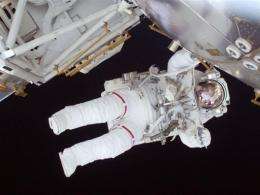A flight engineer participates as construction and maintenance continue on the International Space Station. Japan is readying to launch its first cargo spacecraft to the International Space Station, aiming for a share of space transport after the retirement of the US space shuttle fleet next year.
Japan early Friday launched its first cargo spacecraft to the International Space Station, aiming for a share of space transport after the retirement of the US space shuttle fleet next year.
The Japan Aerospace Exploration Agency (JAXA) launched the unmanned H-II Transfer Vehicle (HTV) atop an H-IIB rocket, which is also on its first flight, as scheduled just after 2:00 am (1700 GMT Thursday), agency images showed.
The HTV was separated from the H-IIB, as planned, about 15 minutes after the launch.
The rocket blasted off from the Tanegashima Space Center on a southern Japanese island, with the HTV carrying 4.5 tons of supplies including food and daily necessities for the six ISS crew, as well as experiment materials.
Later this month, in an unprecedented attempt, astronauts will operate a Canadian robotic arm at the ISS to grab the HTV and dock it as the vehicle approaches the station.
The 10-metre (33-foot) long cylindrical vehicle, which cost 20 billion yen (217 million dollars), will deliver the supplies, load waste materials and return to Earth, burning up as it reenters the atmosphere.
Japan has spent 68 billion yen developing the vehicle, which is designed to be modified in future to carry humans.
Japan currently has no spacecraft that can send man into space.
JAXA plans to launch one HTV every year until 2015.
The HTV can carry up to six tons of supplies to the ISS, compared with 7.5 tons for the Automated Transfer Vehicle developed by the European Space Agency, and 2.5 tons for Russia's Progress spacecraft, the Japanese agency said.
The H-IIB is also a new rocket for Japan, developed jointly by JAXA and Mitsubishi Heavy Industries.
(c) 2009 AFP



















